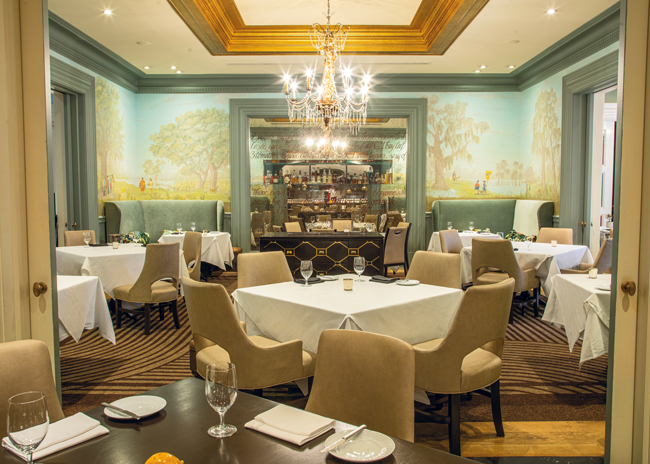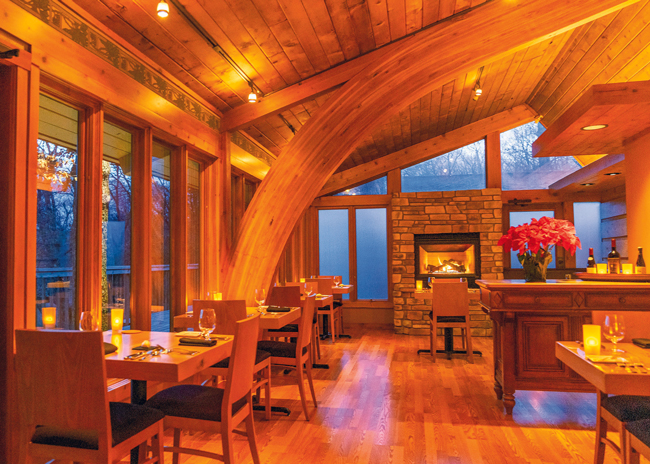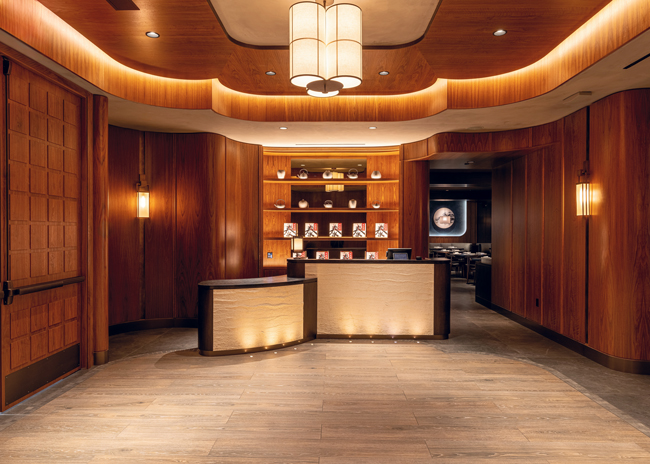Whether you’re talking about the expected (resorts, private clubs, hotels) or unexpected (eatertainment, anyone?), the term “high-end” becomes a common way to describe a variety of properties these days. But just because a place calls itself “high-end,” doesn’t make it so.
While Dan Dobrowolski, founder and owner of Canoe Bay, a secluded Relais & Châteaux resort in northwestern Wisconsin, recognizes that high-end, when it comes to resorts, is “in the eye of the beholder to some degree,” these properties often offer some features that set them apart. “Most importantly, they need to have a distinctive point of view and execute it at a high level,” he says. “They’re constantly in a state of improvement and making things better.”
And he should know. Dobrowolski completed a multimillion-dollar facelift of the 30-year-old secluded Canoe Bay country estate that encompasses 300 acres with three private spring-fed lakes. Designed for couples, the resort upgraded much of its property, including its vegetable garden, kitchen, wine cellar and dining room.
That make-it-better mindset is something Timothy Wedell, executive chef of Sheraton Grand Chicago Riverwalk, knows a thing or two about, both in his current role and previous ones. Wedell was the chef de cuisine at Augusta National Golf Course, home of The Masters Golf Tournament, where he worked in the main clubhouse for seven years. “The key point about Augusta National Golf Club is that everything is either perfect or in the process of being perfected,” he says.
To prove his point, Wedell recalled an incident when, during a busy tournament lunch service, the warmed plate cabinet malfunctioned. “Right after the service, it was like watching a NASCAR pit crew. Two engineers arrived, swiftly removed the faulty unit and installed a new one, all within about 20 minutes. In a typical hotel or stand-alone operation, such a replacement could take days or even weeks.”
 Restaurant R’Evolution, located in New Orleans, recently underwent an extensive refurbishment. Its classically elegant design provides a thoughtful contrast to the modern, imaginative reinterpretations of classic Cajun and Creole cuisine by acclaimed chef John Folse. Photo by Kat Kimball, photo courtesy of Restaurant R’Evolution
Restaurant R’Evolution, located in New Orleans, recently underwent an extensive refurbishment. Its classically elegant design provides a thoughtful contrast to the modern, imaginative reinterpretations of classic Cajun and Creole cuisine by acclaimed chef John Folse. Photo by Kat Kimball, photo courtesy of Restaurant R’Evolution
Overall Trends
But above-and-beyond service represents only part of the high-end property puzzle. Keeping up with culinary and foodservice trends — and acting quickly to implement them — becomes paramount at this level.
For Nick Morales, senior project manager/foodservice design consultant at Cini-Little, two of the biggest trends when it comes to high-end property foodservice have been the desire for international flavors and a change in the traditional dining room ambience. “What I’ve been seeing and hearing from a lot of the clubs I’ve worked on is the younger generation is coming in and wanting to take part in them,” says Morales. “They want to feel as if they are going on a mini vacation kind of atmosphere.”
 Photo courtesy of Canoe BayThat’s a sentiment echoed by Ed Doyle, president of RealFood Hospitality, Strategy & Design. “Clubs used to be benchmarked against other clubs, but now it’s against members’ favorite restaurants,” he says. “So, where that cobb salad, turkey club or filet mignon might have been okay, members are now looking for a higher level of creativity, more eclectic food and beverage offerings and immersive experiences that go far beyond what you might typically find in a club setting. Gone are the days where we may have been successful having a grill room where the biggest conversation was do we or do we not put an ‘e’ on the name.”
Photo courtesy of Canoe BayThat’s a sentiment echoed by Ed Doyle, president of RealFood Hospitality, Strategy & Design. “Clubs used to be benchmarked against other clubs, but now it’s against members’ favorite restaurants,” he says. “So, where that cobb salad, turkey club or filet mignon might have been okay, members are now looking for a higher level of creativity, more eclectic food and beverage offerings and immersive experiences that go far beyond what you might typically find in a club setting. Gone are the days where we may have been successful having a grill room where the biggest conversation was do we or do we not put an ‘e’ on the name.”
Beyond the continuous need to exceed guests’ expectations, Brandon Dixon, senior designer at TriMark USA, also sees a desire for dynamic, almost theatrical dining experiences. “Things like utilizing elements of open kitchens or even tableside performance cooking make the guest feel more like they are experiencing something beyond your traditional meal,” he says. “One of the biggest requests from clients I get are for visibility of the action.” That can include equipment that can become a focal point such as a solid fuel grill or a showpiece pizza oven.
A serious commitment to sustainability represents another trend Wedell sees at high-end properties. “Guests increasingly want to feel like they are contributing positively to the environment.”
For example, although sustainability and wellness were built into the concept at Canoe Bay, that doesn’t mean there isn’t room for improvement. Upgrades were made to the expansive organic garden, which grows 100 or so seasonal varieties of vegetables, herbs, fruit and other edibles for the resort’s menus. Spa cottages now feature steam showers, saunas and whirlpools.
Foodservice in nontraditional areas is another area of change for this sector. “During COVID, everybody realized that their club was a great third place to work,” says Doyle. “That empty lobby is now a workspace where guests expect to have a great cup of coffee and want it to be a replacement for their local hipster coffeeshop.” Resort and private club foodservice has also expanded to the pool area.
 When it was first created, the owner of Canoe Bay, a 300-acre Relais & Châteaux resort in northern Wisconsin, enlisted a protégé of Frank Lloyd Wright to design it. More than 30 years later, a multimillion-dollar renovation preserved the Prairie-style architecture while adding in modern comforts befitting the adults-only picturesque resort. Photo courtesy of Canoe Bay
When it was first created, the owner of Canoe Bay, a 300-acre Relais & Châteaux resort in northern Wisconsin, enlisted a protégé of Frank Lloyd Wright to design it. More than 30 years later, a multimillion-dollar renovation preserved the Prairie-style architecture while adding in modern comforts befitting the adults-only picturesque resort. Photo courtesy of Canoe Bay
“Nontraditional” aptly describes one of Morales’ current projects: foodservice operations on a private island in the Bahamas that will service two cruise ship lines. Currently the project features four large foods halls, multiple bar areas, and beach clubs with bar and food offerings. “The biggest challenge is meeting the expectations of the client and operation team as they all have their say in what they want,” he says. Starting conversations early with the operation team is vital to alleviate any kind of changes they may want down the road once they start reviewing documents. “The sooner you can get that handled and coordinated with each other, the better.”
Designing foodservice operations in more traditional club settings comes with problems too. “Probably some of the biggest challenges I have encountered while doing clubs is most of them are in existing buildings they’re trying to renovate, and that’s always a struggle versus new builds,” says Morales, citing code requirements as an issue that comes up often.
Then there’s the club challenge of members who visit multiple times a week. “We’ve seen menus get smaller and more dynamic with a greater range of specials, where you have the ability to create new content without making everyone feel like they are losing their minds trying to keep up to the changes in the menu,” says Doyle. “Trying to be everything to everybody is a disaster. You are good at nothing then.”
While clubs with multiple outlets have more flexibility, those with a single foodservice offering can take advantage of intentional pop-up experiences, says Doyle, such as special wine, bourbon or beer dinners. “Like in the commercial world, we need to market, promote and communicate in a way that celebrates the work that the team has done.”
At Swing Racquet + Paddle, a racquet and paddle sports concept that broke ground in August, Dixon will have plenty of opportunities to deliver on a variety of high-end and more casual foodservice operations. Spanning 45 acres in Raleigh, N.C., the flagship “sportstainment” property, a trademarked term that expands on the eatertainment trend, has partnered with celebrity chef Fabio Viviani to deliver a destination dining experience.
Part of the extensive foodservice offerings will include a building housing a central kitchen, event spaces, coffee bars and a catering kitchen servicing the rest of the campus. The design will also include indoor and outdoor bars and kitchens, pantry pavilions at the various racquet centers and a cafe at the indoor tennis center. Appropriate to the property itself, food and beverage items will lean into health-focused offerings, such as smoothies, yogurt parfaits and acai bowls.
For this property and other high-end ones he works on, Dixon keeps back-of-the-house flow central to his kitchen design. “The same time I am laying out a kitchen, I am envisioning the people in it and watching them walk through the kitchen,” he says. “I’m trying to reduce their reach and number of steps to create a more comfortable environment to work in.” He credits Robbie White, TriMark’s account executive on the Swing Racquet + Paddle project, as being “instrumental to the success of the design and equipment specifications for the project.”
Morales always likes to get feedback early in the process from the back-of-the-house teams. “They’re in the trenches, so they are experiencing it day in and day out. It’s totally
different than just putting it on a piece of paper.”
Working with foodservice and in concept and operations, gives RealFood an advantage, says Doyle. “We really need to start with the guest experience and what the client’s strategic measures are and build back from that.”
 Located in Chicago’s Streeterville neighborhood, Sheraton Grand Chicago Riverwalk features four dining outlets and 125,000 square feet of event space, headed up by Executive Chef Timothy Wedell. Photo courtesy of Sheraton Grand Chicago Riverwalk
Located in Chicago’s Streeterville neighborhood, Sheraton Grand Chicago Riverwalk features four dining outlets and 125,000 square feet of event space, headed up by Executive Chef Timothy Wedell. Photo courtesy of Sheraton Grand Chicago Riverwalk
Equipment Trends
Choosing the right equipment, now more than ever, plays a big role at high-end resorts and clubs with newer technologies offering solutions to challenges, including location limitations, staffing issues and training.
“‘Flexibility’ has become a word that we lean into a lot more than we used to because COVID woke us up to the fact that tomorrow you might need to be doing takeout,” says Doyle. “I think the idea of how we create spaces that are going to flex and be dynamic is important.”
Given how often menus will change in high-end concepts, having a flexible equipment package becomes even more important than before. Morales points to conveyor ovens as one such example. “You can use it for pizzas, but you can also use it for sandwiches and a large range of different food offerings.”
For Dixon, finding equipment that staff can move easily plays a crucial role in his design work at Swing Racquet, given the extensive foodservice operations in play. “Having equipment specified with casters will enable it to be moved easier for cleaning and provide a more flexible kitchen layout that will adapt to their evolving needs,” he says.
But with that mobility, the question of proper ventilation comes into play. “The ability to deploy a range of ventless solutions these days, whether it’s a convection oven or ventless impingement, has led us to do more in places than we thought we could,” says Doyle.
 Famous for its xiao long bao (soup dumplings), Taiwanese chain Din Tau Fung recently opened its first East Coast location. The New York City restaurant features 120 tables. Photo courtesy of Din Tau Fung
Famous for its xiao long bao (soup dumplings), Taiwanese chain Din Tau Fung recently opened its first East Coast location. The New York City restaurant features 120 tables. Photo courtesy of Din Tau Fung
As an answer to that lack of ventilation issue, as well as others, electric equipment has gained in popularity. “The big push is all electric,” says TriMark USA’s Ryan Abellana, director of operations for high-end properties. “We are starting to do a lot of large electric cooking suites, especially some of the high-end import suites.”
Another high-end equipment trend relates to eye appeal. “The current new expectation is high-end finishes absolutely everywhere,” including throughout the kitchen, says Abellana. “The biggest challenge is the wow factor.” Part of that is accomplished through being open to working with manufacturers and custom subcontractors to add additional finishes to equipment. “The majority of the time, what they are looking for isn’t an actual product, and we have to make it happen for them.”
Creating visually appealing spaces has meant reduction of equipment with stainless-steel finishes. “Any time you are front of the house, they want to try to eliminate the visibility of stainless steel because of its institution aesthetics,” says Morales, adding that the addition of decorative millwork or a front facade is often the solution.
Oftentimes, says Dixon, bars become the first pieces of foodservice equipment guests see when they enter a resort or club restaurant, making their visual appeal especially important — though operators should keep in mind that countertops with unique shapes can create design layout issues when it comes to the needed equipment.
As with all aspects of foodservice operations, smart equipment is something many operators (and by association, designers) are taking a close look at.
Sheraton’s Wedell is in the process of doing an overall modernizing of the downtown Chicago hotel’s extensive kitchen spaces. “We are looking at intelligent cookware that meets our varying demands,” he says. Currently, he is working with their vendors to get some concept and beta test models in their kitchens for the team to play with and send feedback on to the manufacturers.
With more people in kitchens who are digital natives, there’s been a big shift to equipment with more touchscreens and capabilities that allow them to operate these items from their phones. Crucial to this new technology is the ability to connect it to menus.
“Sometimes we find there are people who buy a Ferrari and then they only drive it in first gear,” says Doyle. “You could go out and buy a $40,000 combi oven and use it like a convection oven, but that wouldn’t be very smart. If we are going to provide a new technology solution to our chefs, we have to make sure they are comfortable with it.”



